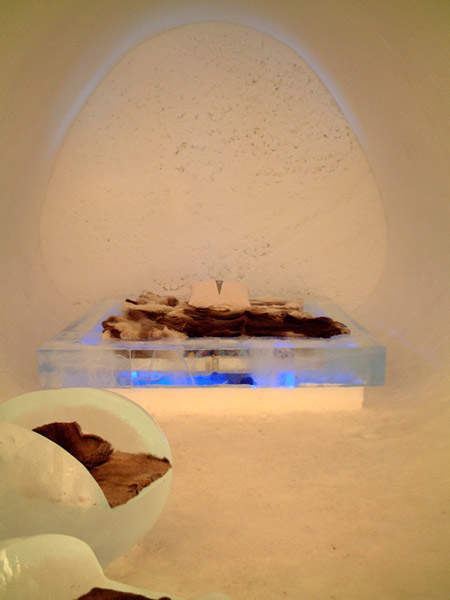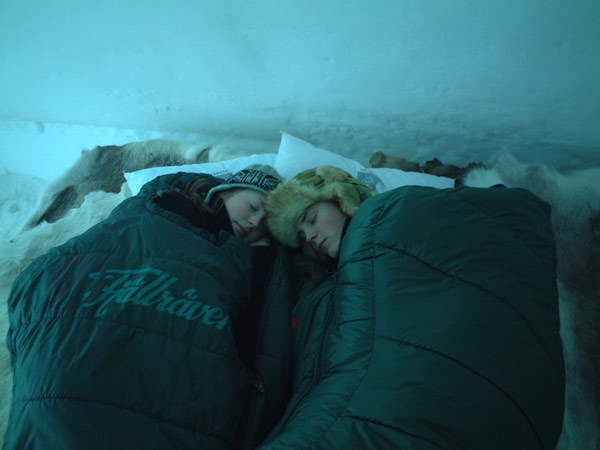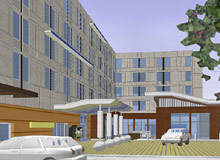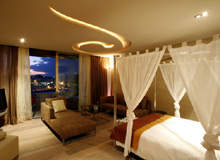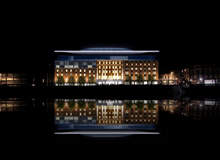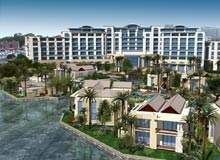Situated 200km inside the Arctic Circle, Ice Hotel is, as the name implies, a hotel completely constructed from ice. Every year the village of Jukkäsjarvi in Swedish Lapland is home to the Ice Hotel. The Ice Hotel is the brainchild of a Swede named Yngve Bergqvist. The Ice Hotel is rebuilt every year using the massive ice resources of the nearby River Torne (hotel opens every December for business).
Last year 14,000 guests stayed at the Ice Hotel, with 37,000 day visitors. Owned by Icehotel AB the hotel features 60 rooms, 25 suites, a cinema, the ‘Absolut’ ice bar, the Iceart gallery, the Icechurch and a sauna – there are many winter activities to do or you can just chill out in the Icebar. The interior temperature hovers just around a very chilly -6ºC (20ºF).
Ice art
Ice Hotel began nineteen years ago out of an idea that had seen an igloo built to house art works created by Japanese ice artists. From a single room structure it has grown into a 5,000m² complex constructed from 30,000t of snow and 4,000t of ice.
A unique feature of Ice Hotel is that every year the architecture of the hotel is changed. Each year artists submit their ideas and a jury selects about 50 artists to create the church, Absolut Icebar, reception, main hall and suites. In 2008-09 a number of artists and sculptors from all over the world worked towards creating monuments and art pieces out of ice. The tilted and square-ish reception was sculpted by the all-Swedish team of Ake Larsson, Mikael Nille Nilsson and Sofi Ruotsalainen. The dancing and twisting columns in the main hall were crafted by another Swedish team of Anders Eriksson and Arne Bergh.
Construction
The construction work on the hotel began in November 2008. Vaulted steel pillars up to 5m high were positioned and thousands of tons of snow moulded around these pillars using snow canons and front loaders to create the super-structure. These pillars were removed after the snow had ‘set’ and used elsewhere. This freestanding structure of snow arches was then reinforced with ice pillars.
After this initial construction phase craftsmen and artists are able to refine the interior – carving the walls, creating the windows, doors, beds, chairs, tables and lamps. The Ice Hotel invites its first guests on 10 December 2008. The hotel usually melts from May onwards, with the water eventually flowing back into the river from where it came.
In March, ice is harvested from the River Torne in huge ice blocks, each weighing 2t, in preparation for the following season. The blocks, stored in a freeze house, are crystal-clear due to the pureness of the river water and the fast-flowing current.
Rooms
The Ice Hotel has more than 80 rooms. Room of different types are available – ARTsuites, ICErooms, SNOWrooms and Group rooms. Special beds made of snow and ice are found in each room. These beds are covered with mattresses and reindeer pelts. Guests sleep in specially designed thermal sleeping bags. The suites are decorated with ice art and sculptures. The indoor temperature of the hotel ranges between -5°C and -8°C depending on the number of guests and the outside temperature.
Warm accommodation is provided as four-bed cabins, Aurora houses, and Kaamos hotel rooms. All warm accommodations include private bathrooms and luggage storage. Visitors can view the Northern Lights from the Aurora house, which has a refrigerator, water boiler, TV, telephone and bathroom.
Facilities
Leisure activities at the Ice Hotel are centred around relaxation. Drinks and a buffet service are provided by The Blue and Cultural saunas. Ice massages are also offered.
Absolut Icebar and a cinema are among other leisure facilities. At the Icebar drinks are refrigerated to keep them warm and the glasses are made of ice to keep them cold. An exciting bar experience is provided by Absolut Vodka, which is served at the Icebar. Absolut Vodka comes from the southern town of Åhus and Ice Hotel is in the northern village of Jukkasjärvi. Pure raw materials are from local sources, such as winter wheat from surrounding farms, spring water from a deep well in Åhus and crystal clear ice from the Torne River in Jukkasjärvi are used at the Absolut Icebar.
Snow mobiles facilitate outside excursions. These include trips to see the local landscape, take a look at the Northern Lights or experience the local Saami culture. The Ice Chapel is a venue for children to get baptised and marriages to be blessed.
Entertainment
Jukkasjärvi and greater parts of Swedish Lapland and northern Norway constitute the main areas of interest. Trips may take the form of one-day snowmobile excursions along the winding Torne River, or trying ice sculpting. Ice Hotel artists introduce visitors to ice sculpting and train them to use special ice implements.
Jukkasjärviis can be experienced by the Combo Ski or Snowshoe Tour. Visitors are geared up for a long skiing experience with a serving of homemade cake and coffee or tea. The Polaris Ranger Razer takes visitors on a ride along dense pine forests, over lakes and frozen rivers. A minibus takes them to the Esrange space base.
Ice Hotels
The ice hotel idea has already spread; the Ice Hotel Québec was opened in 2000 in the area of Duchesnay just outside Québec, Canada. In 2004, the United States saw its first ice hotel, the Aurora Ice Hotel at the Chena Hot Springs Resort in Fairbanks, Alaska. During its construction, state officials cited the hotel’s owner for fire code violations and did not permit the building to open until smoke detectors and fire extinguishers had been installed in each room.
Although the initial structure melted in the Spring of 2004, it was rebuilt for the 2005 season, this time inside a larger, protective refrigerated structure (the walls have a refrigerated pipe running through them and there is an insulated jacket on the outside to protect from rain and summer heat), with the goal of keeping it frozen and habitable year-round.






